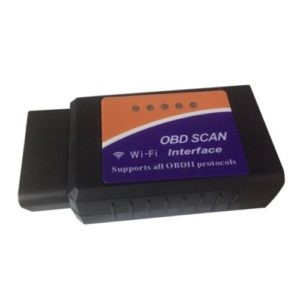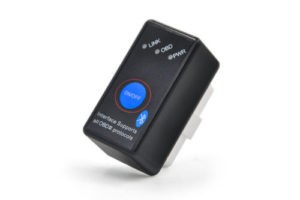For car enthusiasts and professional mechanics alike, understanding your vehicle’s health is paramount. Modern vehicles are equipped with sophisticated onboard diagnostic systems, and to access this data, you need an Obdii Converter. Often referred to technically as an ELM327 adapter, this device acts as the crucial intermediary between your car’s computer and diagnostic software on your smartphone, tablet, or computer. Choosing the correct OBDII converter is not just about connectivity; it’s about ensuring accurate data retrieval and a seamless diagnostic experience.
This guide will delve into the essential aspects of selecting an OBDII converter, ensuring you make an informed decision for effective car diagnostics. Whether you’re a seasoned mechanic or a car owner keen on understanding your vehicle better, this information will be invaluable.
Understanding OBDII Converter Types: Connection is Key
When selecting an OBDII converter, the first crucial step is understanding the different connection types available. Compatibility with your device (smartphone, tablet) hinges on this choice. Converters primarily connect wirelessly, and understanding the nuances of each type is essential.
Here’s a breakdown of the main OBDII converter connection types:
-
WiFi OBDII Converters: These converters establish a direct WiFi connection with your device. While offering good data transfer speeds, they can sometimes lead to connectivity conflicts, particularly with mobile data on smartphones. This is because your device might prioritize the OBDII converter’s WiFi network over your mobile internet connection.
-
Bluetooth Classic OBDII Converters (Versions 1.x, 2.x, 3.x): These are traditional Bluetooth connections, widely compatible with Android devices. They generally offer a reliable connection and faster data transfer rates compared to Bluetooth LE. For Android users, classic Bluetooth OBDII converters are often a preferred choice.
-
Bluetooth Low Energy (LE) OBDII Converters (Version 4.0 and above): Bluetooth LE is designed for low power consumption, making it ideal for devices where battery life is a concern. Critically, Bluetooth LE is the primary connection type supported by Apple iOS (iPhone/iPad) for OBDII converters. Due to iOS limitations, classic Bluetooth converters generally won’t work with iPhones and iPads.
-
Bluetooth MFi OBDII Converters: These are a specialized category of classic Bluetooth converters designed to work with Apple iOS devices. Manufacturers of MFi (Made For iPhone/iPad/iPod) accessories must undergo certification with Apple, which adds to the cost. These converters offer classic Bluetooth speeds and compatibility with iOS but are typically more expensive and less common. Examples include OBDLink MX+ and vLinker FS. On Android devices, these MFi converters function as standard Bluetooth converters.
-
USB OBDII Converters: While USB connections offer a wired, reliable connection, it’s important to note that USB OBDII converters are not compatible with the Car Scanner app. Car Scanner is designed for wireless OBDII converters only.
For Apple iOS (iPhone/iPad) users, Bluetooth LE OBDII converters are generally the most recommended. They provide a balance of ease of connection, acceptable speed, and availability. Bluetooth MFi converters are a premium option for maximum speed, while WiFi can present connectivity challenges.
For Google Android users, classic Bluetooth OBDII converters are often recommended. They offer speed and reliability. However, some Android devices may experience conflicts when connected to multiple Bluetooth devices simultaneously (like an OBDII converter and a car’s Bluetooth multimedia system).
Quality Matters: Distinguishing Good from Bad OBDII Converters
Beyond connection type, the quality of your OBDII converter is paramount. In the realm of OBDII converters, especially ELM327-based ones, quality differences are significant and can dramatically impact your diagnostic experience.
It’s crucial to understand that in terms of functionality, OBDII converters are broadly categorized as “good” or “bad.” A “good” converter functions reliably, providing accurate data without glitches or freezes. Conversely, “bad” converters are plagued with issues that can range from minor annoyances to serious problems.
Common Issues with “Bad” OBDII Converters:
-
Complete Non-Functionality: Some converters simply fail to work at all, rendering them useless.
-
Unstable Operation: These converters might work intermittently, freezing after a short period, spontaneously rebooting, or failing under varying temperature or humidity conditions. Inconsistency is a hallmark of a bad converter; it might work one day and fail the next, or show different data sets inconsistently.
-
Incomplete Command Support: Many subpar converters claim to support all standard OBDII commands but, in reality, only support a subset. This limits their diagnostic capabilities.
-
Fixed ECU Address Limitations: Some faulty converters are hard-coded to communicate with only a specific Engine Control Unit (ECU) address, preventing communication with other ECUs in your vehicle. Modern vehicles have multiple ECUs for different systems (ABS, Airbags, etc.).
-
Data Length Restrictions: Bad converters might impose limits on the length of data requests and responses, truncating crucial diagnostic information.
-
Data Loss and Corruption: These converters can lose data packets during transmission or reception, leading to incomplete or indecipherable data sets. Imagine receiving only parts of a message – the information becomes meaningless.
-
Data Distortion: Even more critically, a faulty converter might distort data, potentially sending incorrect commands to your vehicle’s ECU. This is extremely dangerous, as sending an “erase memory” command instead of a “temperature request” could have severe consequences.
-
Protocol Incompatibility: OBDII converters are designed to support various communication protocols used by different car manufacturers. A bad converter might only support a limited set of these protocols. If your car uses an unsupported protocol, the converter will simply not work.
-
On-Board Network Interference: Alarmingly, some low-quality converters can inject “junk data” or spam requests onto your car’s on-board network (CAN bus). This interference can disrupt the ECU’s ability to control the engine and other systems, potentially causing engine roughness or other malfunctions.
-
Unsuitability for Advanced Functions: If you intend to use your OBDII converter for advanced functions like “Coding and Service” (writing data to the ECU), a high-quality converter is absolutely essential. Data writing is a critical operation, and a bad converter can lead to data corruption and severe vehicle malfunctions.
The market is unfortunately saturated with more “bad” OBDII converters than “good” ones. The risk of purchasing multiple faulty converters before finding a reliable one is real.
Recommended OBDII Converters: Quality and Reliability
To help you navigate the market and choose a reliable OBDII converter, here are some recommended models, categorized by quality and features. These recommendations are based on user feedback and expert experience within the car diagnostic community.
(Note: The following links are affiliate links, and as an Amazon Associate, I earn from qualifying purchases.)
Top-Tier OBDII Converters (Highest Performance & Reliability):
-
OBDLink MX+ with Bluetooth MFi: (Approx. $100 USD). Compatible with iOS and Android. This is the most advanced and feature-rich OBDII converter on the list. Its MFi certification ensures seamless compatibility with Apple devices, while its robust Bluetooth performance is excellent for Android as well. Ideal for users who demand the best performance and are willing to invest in top quality.
-
OBDLink CX with Bluetooth LE: (Approx. $80-100 USD). Compatible with iOS and Android. Featuring Bluetooth LE, the CX is optimized for iOS devices but also works well with Android. It boasts a large memory buffer and excellent overall performance, making it a strong contender for both platforms.
Mid-Range, High-Value OBDII Converters:
-
vLinker MC+ with Bluetooth LE: (Price varies). Bluetooth LE, suitable for iOS and Android. vLinker has emerged as a reliable brand, and the MC+ is a solid Bluetooth LE option. Firmware updates have improved its performance significantly.
-
vLinker FS with Bluetooth MFi: (Price varies). Bluetooth MFi, ideal for iOS, also works with Android. The FS model offers MFi certification for enhanced iOS compatibility, along with the improved vLinker firmware.
-
Vgate iCar Pro 2S: A newer iteration replacing the iCar Pro BLE, the 2S is a generally improved model. If choosing between the two, the 2S is the recommended option.
-
Vgate iCar Pro BLE: (Price varies). This converter is compatible with all operating systems (iOS, Android, Windows) due to its Bluetooth 2.0 + Bluetooth 4.0 chip. However, older firmware versions had issues with CAN Extended addressing in some car brands (Toyota, BMW). Ensure you update to firmware version 4.1.02 (or later) from 2021/01/08 to resolve this. Firmware updates are available for download online.
OBDII Converters to Avoid: Red Flags and Problematic Brands
To further guide you away from problematic purchases, here is a list of OBDII converter types and brands to generally avoid:
-
xTool Adapters: These are not ELM327 compatible and only work with xTool’s proprietary software, limiting their versatility.
-
Wired (USB, COM) Adapters: As mentioned earlier, Car Scanner and many modern diagnostic apps are designed for wireless OBDII converters. Wired adapters are generally not compatible.
-
“Mini” Adapters: OBDII converters with “mini” in their name are overwhelmingly likely to be low-quality. Avoid these.
-
Extremely Cheap Adapters: If an OBDII converter seems too good to be true in terms of price, it probably is. Very cheap converters are often plagued with quality issues.
-
Adapters with MAC Addresses Starting with 11:22:33 or 00:00:00: These MAC addresses are often associated with generic, low-quality clones.
-
KONNWEI Devices (Recent Models): While previously recommended, recent KONNWEI OBDII converters have shown a decline in quality, frequently exhibiting data packet loss.
-
“Micro Mechanic” Brand: Converters under this brand are reported to have a high failure rate after a short period of use.
-
“THINMI.COM” Brand: These adapters have limited ELM327 command support and are known to generate many fake responses, making them unreliable for accurate diagnostics.
-
“KUULAA” Brand Adapters: Avoid OBDII converters from this brand due to reported quality issues.
-
Specific Physical Design (See Images Below): Converters that look like the examples below, while sometimes compatible, are frequently of very low quality.
 badelm1-1
badelm1-1
 badelm2
badelm2
 badelm3
badelm3
 badelm4
badelm4
 badelm5
badelm5
These images illustrate common designs associated with lower-quality OBDII converters. While visual appearance isn’t the only indicator, recognizing these designs can be a helpful red flag. The alt text for these images will further reinforce the concept of avoiding these designs.
Conclusion: Investing in the Right OBDII Converter for Reliable Diagnostics
Choosing the right OBDII converter is a critical step in ensuring accurate and reliable car diagnostics. By understanding the different connection types, prioritizing quality over price, and being aware of problematic brands and designs, you can make an informed decision. Investing in a reputable OBDII converter will save you from frustration, data inaccuracies, and potentially harmful interactions with your vehicle’s sensitive electronic systems. Whether you are using the Car Scanner app or another diagnostic software, a quality OBDII converter is the foundation for effective vehicle health monitoring and maintenance. Choose wisely, and empower yourself with the knowledge to keep your vehicle running smoothly.
